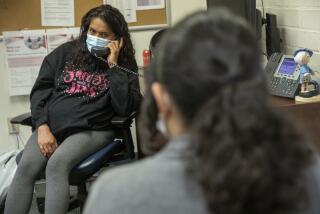In-store clinics look to be a remedy for healthcare law influx
If you thought it was hard getting a doctor’s appointment now, just wait until 30 million more Americans join the line. Nearly 3 in 4 California counties already lack a sufficient number of family physicians, and by 2020 the U.S. faces an estimated shortage of 40,000 primary-care doctors with no way to remedy that in just a few years
As a result, more consumers may soon find themselves getting their checkups and help in managing their high blood pressure, heart disease or diabetes at the local pharmacy or Wal-Mart as the Affordable Care Act extends health insurance to 30 million people and puts unprecedented strain on an already fragile network of primary care.
Pharmacy giant CVS Caremark Corp., Target Corp. and other retailers are aiming to help alleviate the doctor shortage with hundreds of walk-in clinics run by nurses to treat ear infections and other routine ailments and increasingly help people suffering from chronic illnesses. These companies, after struggling to turn a profit from these clinics for the last decade, are now eager to capitalize on an influx of newly insured patients.
“People could have long wait times to see a doctor as the federal law gets implemented in 2014, and that will drive more interest in these retail clinics,” said Ateev Mehrotra, a researcher at the University of Pittsburgh School of Medicine and Rand Corp., a nonprofit think tank in Santa Monica.
An estimated 4 million Californians will receive health coverage under the law, and one of those recipients is likely to be Silvana Washington, a 57-year-old home-health aide in Los Angeles with diabetes and hypertension.
Washington often waits as long as three hours to be seen at a county-run medical clinic that serves the uninsured. She said she would welcome more options, like getting her blood pressure checked during a weekend shopping trip.
“I think a lot of people would like that,” Washington said.
Experts say it remains to be seen whether more clinics at the workplace or close to home just create more unnecessary care that drives the nation’s $2.6-trillion medical tab even higher. There are also concerns that a proliferation of these clinics will undermine efforts in the healthcare overhaul to better coordinate care, particularly for patients whose conditions are among the most complex and expensive to treat.
These clinics are already popular with consumers who like the idea of strolling in for care with no appointment seven days a week. They are typically small operations adjacent to the pharmacy where one nurse practitioner may see patients and handle billing. There are no doctors on site.
Most health insurers consider these clinics an in-network visit, so people are responsible for their standard co-payment, and the uninsured may pay $70 to $90 for a visit.
Monique Howard of Arcadia, a special-education teacher, brought her 12-year-old son, Blake, to a CVS MinuteClinic this month for a $49 physical he needed for youth football, and they were seen right away. Her pediatrician recommended the clinic because the doctor’s office would have charged $150 because her insurance didn’t cover another annual physical until August.
The weekend and evening hours would be a plus for her husband, who doesn’t like to miss work to see the doctor, she said. “I think I found the best-kept secret in town.”
There are more than 1,350 in-store clinics nationwide, according to research firm Merchant Medicine, and that number could top 3,000 by 2016. CVS MinuteClinic, which is the biggest retail clinic chain with nearly 600 locations, plans to open 100 clinics a year. RivalWalgreen Co. has more than 350 Take Care Clinics. Wal-Mart has nearly 150 in-store clinics, and Target is opening nine more this week, raising its total to 53.
These in-store clinics have performed well thus far. Studies by Rand found that these clinics provide care at costs that are 30% to 40% less than similar care provided at a physician’s office and that the care for routine illnesses was of similar quality.
Catherine Dower, a healthcare researcher at UC San Francisco, said these clinics may find it harder to maintain that track record as they expand beyond their limited menu of services.
“Nurse practitioners can do a fine job managing many chronic conditions, but if someone has a more complex problem, they might need to refer to a doctor,” Dower said. “There are pros and cons to expanding the care retail clinics offer.”
In a sign of the grudging respect these walk-in clinics are getting from the medical establishment, UCLA Health System last week agreed to partner with CVS on 11 clinics in Los Angeles County. UCLA physicians will serve as off-site medical directors for the clinics, and the two organizations will share electronic medical records.
Some physicians still aren’t sold. The American Academy of Family Physicians endorsed several clinic chains in 2007 that adhered to certain principles on patient care.
Glen Stream, a family physician in Spokane, Wash., and the group’s president, said that endorsement was canceled after retail clinics began offering more services for the chronically ill that the group felt should be handled by physicians and not the clinics.
“That crossed the line,” Stream said.
Andrew Sussman, president of CVS MinuteClinic, said his clinics don’t intend to replace people’s primary-care physician, but rather help keep patients healthy between doctor visits. He also notes that about half the patients seen at walk-in clinics don’t have a primary-care physician.
CVS gives every patient a printout of their medical record when they leave and offers to send information electronically to their physician.
“We collaborate with physicians in many ways to close the loop,” Sussman said. “We can be an important point of entry into the traditional healthcare system.”
California and many states have enough medical providers to serve the overall population, researchers say, but they are distributed unevenly and that produces shortages in many inner-city and rural areas. The problem is expected to worsen as more primary-care doctors retire and medical school graduates continue to choose more lucrative specialties, in part, to help pay off their student debt.
State Sen. Ed Hernandez (D-West Covina), chairman of the Senate Health Committee, said California must take numerous steps to address this issue, such as encouraging more physicians to practice in underserved areas and perhaps allowing pharmacists to administer vaccines and screen patients for chronic conditions such as diabetes.
Hernandez said he is also considering legislation that would expand the scope of practice for nurse practitioners so they can treat more patients directly with limited physician oversight.
“We will be requiring everyone to purchase health insurance, but what good is coverage if they can’t see someone for care?” Hernandez said.
David Feinberg, president of the UCLA Health System, said that if his partnership with CVS succeeds he could see UCLA specialists eventually using technology to evaluate patients remotely at a MinuteClinic. For now, CVS will refer patients needing more specialty care or a permanent primary-care physician to other local medical providers, including those at UCLA.
“We are really good at saving lives, delivering babies and transplanting organs,” Feinberg said. “We don’t have their retail experience.”
More to Read
Inside the business of entertainment
The Wide Shot brings you news, analysis and insights on everything from streaming wars to production — and what it all means for the future.
You may occasionally receive promotional content from the Los Angeles Times.











